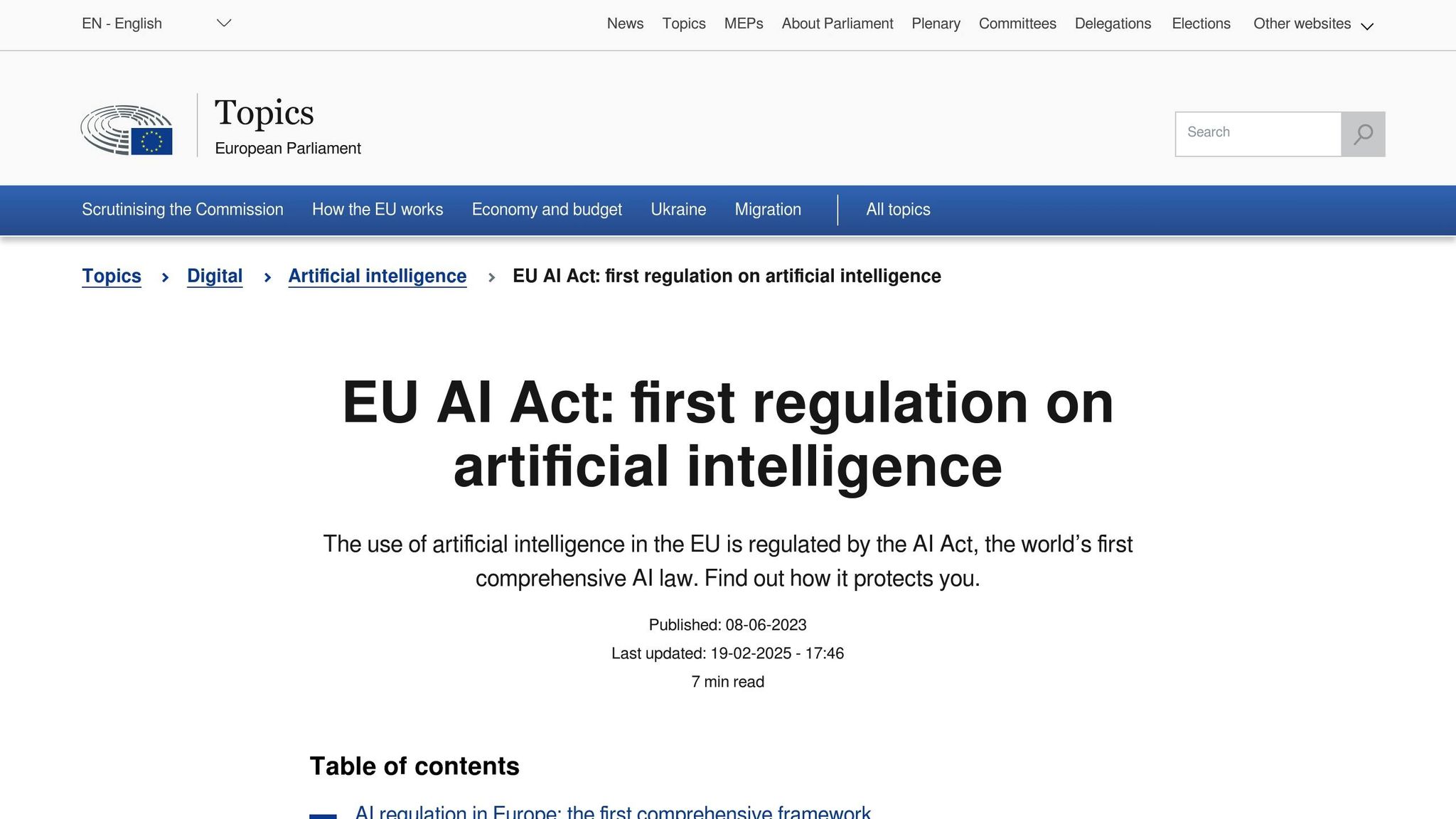
AI-generated content is now under stricter regulations in 2025. With AI detection tools reaching 98% accuracy, global laws are focusing on transparency, accountability, and protecting users from misuse. Key updates include:
- Content Labeling: Mandatory watermarking and metadata tagging for AI-created materials.
- Deepfake Restrictions: Tougher laws to prevent harmful uses of synthetic media.
- Copyright Clarity: New rules on training data sources and intellectual property.
- Risk Assessments: Organizations must evaluate and document risks tied to AI-generated content.
- Energy Reporting: Companies must track and disclose AI system energy use.
The EU leads with its AI Act, effective March 2025, setting standards for labeling, audits, and risk management. To comply, businesses are adopting advanced detection tools and prioritizing transparency in their processes.
These regulations aim to balance innovation with safety, ensuring AI content benefits users without causing harm.
Current AI Content Laws Worldwide
As of 2025, efforts to regulate AI-generated content are ramping up across the globe. The European Union is at the forefront with its AI Act, offering one of the most structured approaches to overseeing AI content.
EU AI Act: Key Requirements

The EU AI Act, which comes into effect in March 2025, introduces a detailed framework for governing AI-generated content. Here are its main provisions:
- A classification system that ranks AI content by risk levels, ensuring content in critical areas undergoes thorough risk assessments and oversight.
- Mandatory digital watermarking and metadata tagging to clearly identify content created by AI.
- Requirements for organizations to document their AI content generation processes and conduct regular audits.
This framework is designed to promote greater transparency, accountability, and ethical practices in the creation and distribution of AI-generated content. It is shaping the global conversation around AI regulation.
Main Changes in AI Content Laws
In 2025, laws around AI-generated content have evolved to emphasize greater transparency and accountability.
Content Labeling Rules
New regulations now require organizations to use digital watermarking to verify the origins of AI-generated content. This step aims to increase clarity and reduce risks associated with AI-produced material.
"Maintain trust and avoid the risks of AI‐generated content." - Detecting-AI.com
In addition to labeling, these rules address broader concerns about the misuse of AI in content creation.
Deepfake Laws
Deepfake laws have been tightened globally to combat the misuse of synthetic media. These changes aim to protect people from deceptive or harmful applications of deepfake technology.
Copyright and Training Data Laws
Lawmakers are also addressing intellectual property and data sourcing issues. Updated copyright rules now require transparency in how data is sourced and provide clearer guidelines for using copyrighted materials in AI training.
These updates highlight the importance of reliable AI detection tools to ensure compliance and uphold the integrity of content.
sbb-itb-207a185
AI Content Distribution Standards
The world of AI content distribution has seen major changes in 2025, with new standards focusing on thorough verification processes and risk management protocols.
Risk Assessment Requirements
Organizations now need to conduct detailed risk assessments to address the effects of AI-generated content in areas like education, business, and research. To meet these updated requirements, organizations should:
- Record possible risks linked to AI-generated content
- Analyze the impact on their intended audiences
- Maintain clear documentation of assessment methods
- Establish systems for ongoing monitoring
After completing risk evaluations, organizations must ensure full transparency regarding their data practices.
Data Disclosure Rules
Transparency has become a non-negotiable in AI content distribution. New rules require organizations to clearly document key details about their AI systems and training data. Here's a breakdown of the required disclosures:
| Disclosure Requirement | Description |
|---|---|
| Data Sources | Origins of training data |
| Model Information | Details about the AI system |
| Content Markers | Digital identifiers for AI-generated content |
| Usage Context | Explanation of how the content is used |
Compliance Tools
Verification tools are now essential for ensuring compliance. These advanced AI detection systems boast text detection accuracy rates of up to 98%. They complement risk assessments and data transparency efforts by offering features such as:
- Identifying AI-generated content across various models
- Generating detailed analysis reports, including highlighted AI-written sections
- Providing percentage breakdowns of AI involvement in text
- Verifying the authenticity of customer reviews and feedback
These tools are critical for enforcing the updated distribution standards effectively.
Next Steps in AI Content Law
Energy Use Reporting
Companies using AI content systems are now required to monitor and share details about their energy use. This includes tracking electricity consumption, carbon emissions, and system performance. The goal is to encourage more eco-friendly AI operations, aligning with broader regulatory goals.
International Law Alignment
In addition to environmental rules, global regulators are working to align AI content laws while acknowledging regional legal and cultural differences. Efforts are underway to create shared protocols for content verification, labeling, and risk assessments. These unified processes aim to help organizations comply with various regional regulations more efficiently. At the same time, policymakers are exploring ways to adjust guidelines for local cultural factors - like language and content sensitivities - while still maintaining consistent global standards.
Conclusion: Meeting 2025 AI Legal Requirements
As AI content regulations become more intricate in 2025, organizations need effective compliance strategies backed by AI detection tools with 98% accuracy. These tools are essential for navigating the varied legal requirements across different regions.
To stay compliant with current AI content laws, organizations should prioritize these three areas:
- Content Verification: Use AI detection systems to review content before publishing, ensuring it meets labeling and disclosure rules.
- Review Authentication: Analyze customer feedback and third-party submissions with detection tools to block fraudulent or misleading content.
- Research Validation: Confirm the accuracy of research data and citations to uphold academic and professional standards.
These steps build on existing risk assessment and data transparency practices, helping organizations integrate AI detection into their workflows. This ensures they stay ahead of evolving regulations.
Energy use reporting and aligning with international laws, as previously discussed, remain critical. By adopting these verification processes, organizations position themselves to meet current legal demands while preparing for future changes. This approach not only supports compliance but also reinforces user trust.